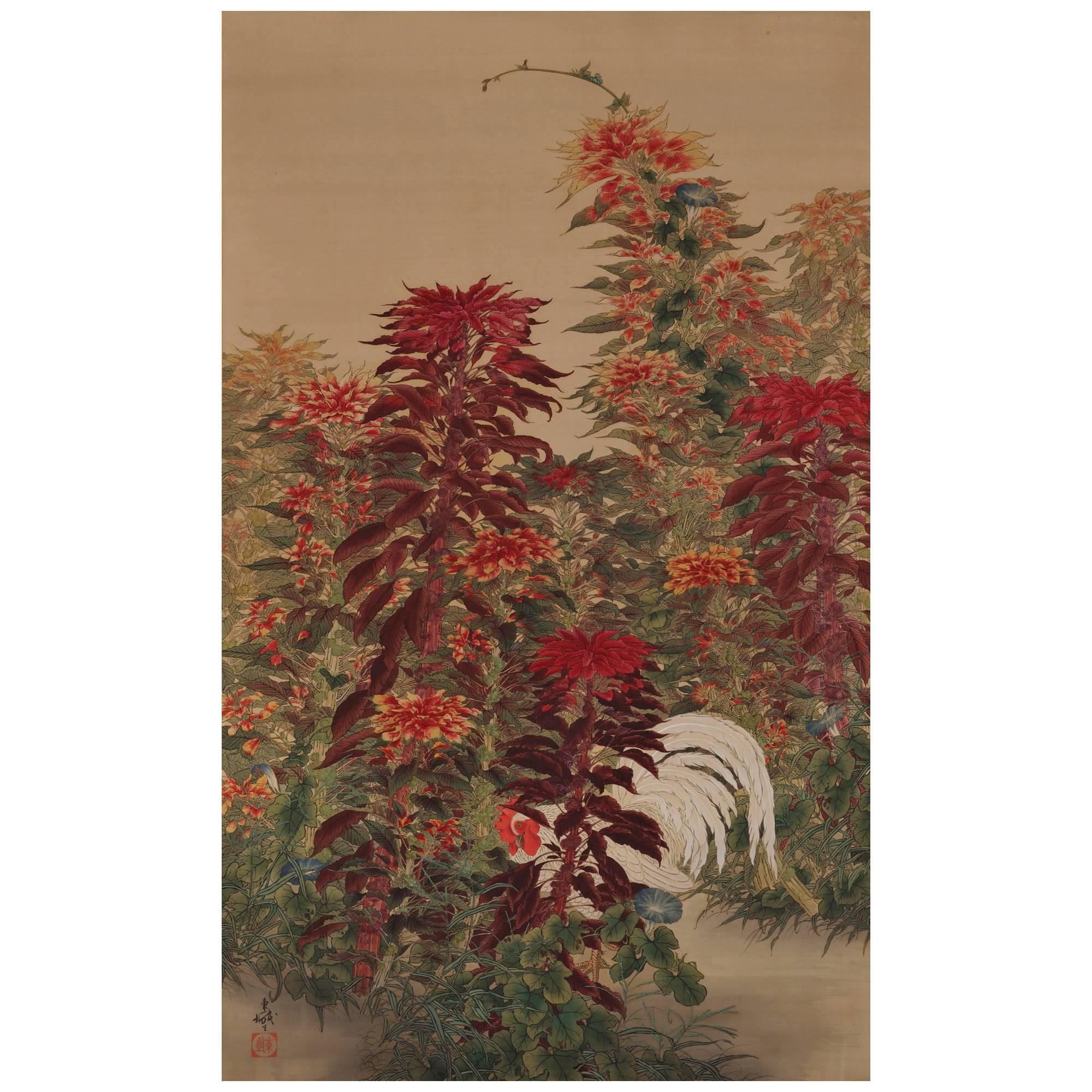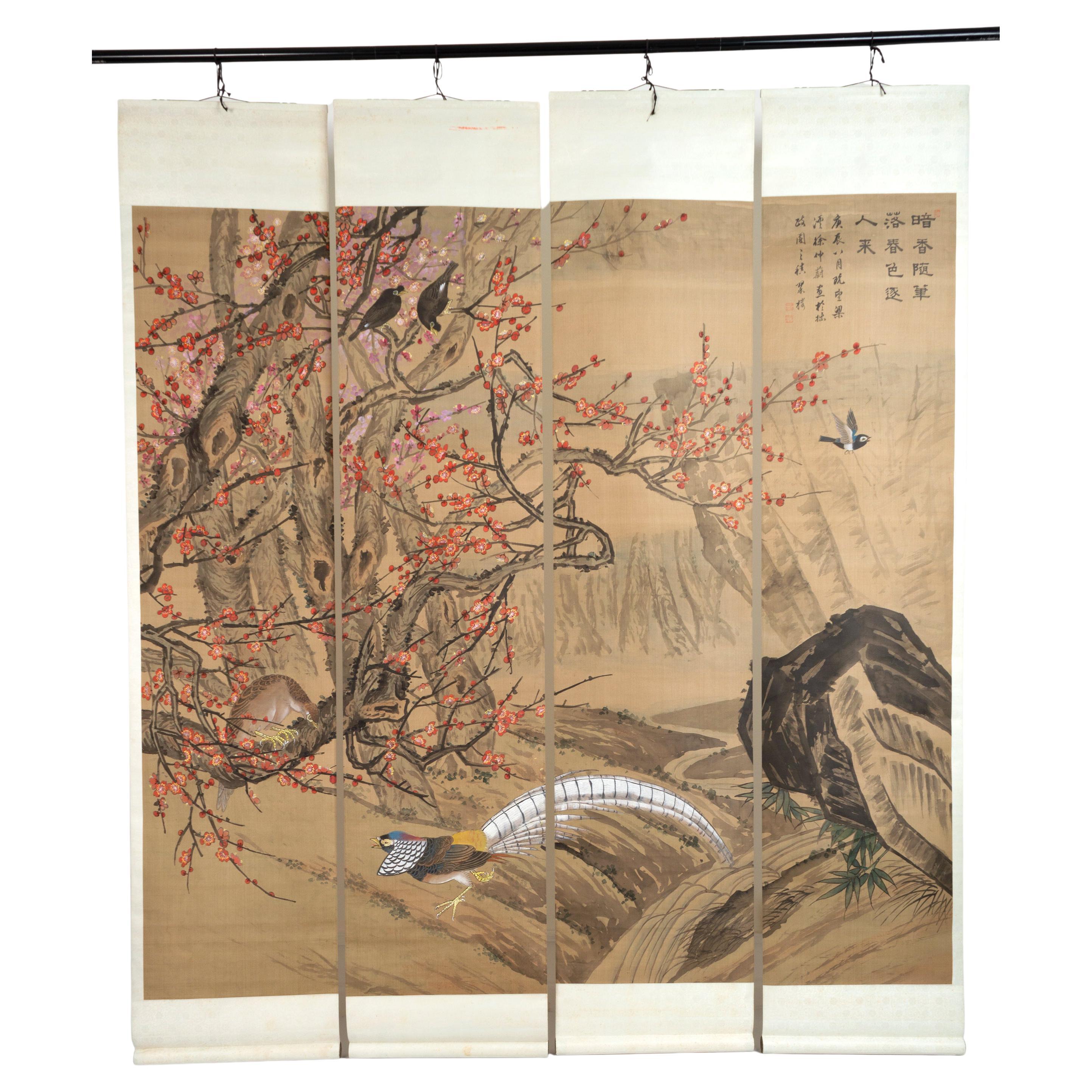Items Similar to Hanging Scroll by Kamisaka Sekka, Japan
Want more images or videos?
Request additional images or videos from the seller
1 of 10
Hanging Scroll by Kamisaka Sekka, Japan
About the Item
This painting represents a man waiting under a dark tree. The composition is extremely simple but suggestive. The artist, with few elements, can, in fact, create a vivid and dynamic scene, based on the tension between the strong ink stain that renders the tree and the elegant figure of the man, dressed in an aristocratic robe.
Painter and designer, Kamisaka Sekka has been one of the most important Japanese artists who brought the traditional aesthetic in the western world. Sekka came from a samurai family - his father was in service at the imperial palace in Kyoto - and studied art during a very delicate period of Japanese history: the transition between the old feudal system of the Edo period to the modern capitalistic one of the Meiji restoration. It has been a traumatic era for all Japanese people and it had relevant effects on artists and their works. In fact, they had to choose between “old” and “new”, between “traditional” and “international”. Sekka chooses the road of national traditions and committed himself in all the fields he could. Under the guidance of his teacher Kishi Kokei, he decided to follow the art of the Rinpa School, using plain and simple designs. What immediately appears from Sekka works is the great use of space, a characteristic of whole Japanese art, based on asymmetric but perfectly balanced compositions.
- Dimensions:Height: 78.75 in (200 cm)Width: 18.9 in (48 cm)Depth: 0.4 in (1 cm)
- Materials and Techniques:
- Place of Origin:
- Period:
- Date of Manufacture:circa 1890-1920
- Condition:
- Seller Location:Milano, IT
- Reference Number:
About the Seller
5.0
Recognized Seller
These prestigious sellers are industry leaders and represent the highest echelon for item quality and design.
Established in 2005
1stDibs seller since 2018
10 sales on 1stDibs
Typical response time: 1 hour
- ShippingRetrieving quote...Ships From: Milano, Italy
- Return PolicyA return for this item may be initiated within 7 days of delivery.
More From This SellerView All
- Ceramic Tea Bowl 'Chawan', by Kamisaka SekkaLocated in Milano, ITA ceramic tea bowl decorated with autumn grasses with signed and sealed tomobako. Painter and designer, Kamisaka Sekka (Japan, 1866-1942) has been one ...Category
Antique 19th Century Japanese Ceramics
MaterialsCeramic
- Painting by Maeda Josaku (Japan, 1926 – 2007), Paysage Humain N° 14, 1960Located in Milano, ITSigned: Josaku Meda. 60. Singed on the back: "Paysage humain" N°14 / 7.1960 / Josaku MAEDA / à Paris Exhibitions: Turin (Italy), Gissi Gallery, Collettiv...Category
20th Century Japanese Paintings and Screens
MaterialsCanvas
- Shibata Zeshin ‘1807-1891’, BarleyLocated in Milano, ITMedium: Hanging scroll; ink and pigments on silk Signature: Zeshin Seal: Tairyukyo Date: circa 1880 Painting size: 98 x 20 cm Mounts size: 182 x 32 cm Shibata Zeshin...Category
Antique Mid-19th Century Japanese Paintings and Screens
MaterialsPaper
- Japanese Folding Screen with a Spring Landscape, Kano School, 19th CenturyLocated in Milano, ITThe scene is dominated by a plum tree in bloom under which a couple of paradise birds is courting. The screen is crossed by a luxuriant creek, a typical feature of the springtime.Category
Antique 19th Century Japanese Paintings and Screens
MaterialsPaper
- Pair of Japanese Two-Fold Screens with Flower Arrangements and Rare BirdsLocated in Milano, ITKaramono with flower arrangements and rare birds Edo period, 18th century Pair of two-panel folding screens Ink, colors, gofun and gold leaf on paper Each 170 by 165 cm ...Category
Antique 18th Century Japanese Paintings and Screens
MaterialsPaper
- Pair of Japanese Screens with Flowers of the Four Seasons, 19th CenturyLocated in Milano, ITThis pair of screens belongs to a genre of lyrical paintings of flowers, grasses, and other plants that flourished around the middle of the 17th century and became a specialty of the Sôtatsu studio. The use of a rather complex composition of clusters of flowers and the puddling of ink was initiated by Tawaraya Sôtatsu, the founder of the Rimpa School, who was active from 1600 until 1642. The screens are abstract and decorative but there is, at the same time, a keen sense of naturalism not only in the attention to accurate detail but in the profusion of vegetation. The passage of the year is symbolized by the variety of plants that bloom in different seasons. The tarashikomi - here used on leaves, petals and trunks - is a Classic Rinpa technique in which pale black ink or a color is brushed onto an area of a painting and then either darker ink, or the same or a contrasting color, is dropped into the first before it has completely dried, creating an effect of pooled colors with softly blurred edges. Its delicacy, preciousness, and effeminacy are identified with the over-refinement of its patrons, while the vigor, monochromatic discipline, sharp observation, and virile forms of the Kano school are a testament to the vitality of the rising warrior class. The plants are almost all identifiable: in the summer-spring part, you can find wheat, buttercups, irises, begonias, hydrangeas, coral bells...Category
Antique 19th Century Japanese Paintings and Screens
MaterialsPaper
You May Also Like
- Two Antique Japanese Hanging Scroll PaintingsLocated in Atlanta, GATwo Japanese scroll painting depicts scenes from the Tale of Genji (Genji-E), from Edo period. These painting were purchased from Odewara Shoten in the...Category
Antique Early 19th Century Japanese Japonisme Paintings and Screens
MaterialsBrocade, Paper
- Antique Japanese Hanging Scroll Attributed to Iwasa MatabeiLocated in Atlanta, GAAn antique ink and color on paper hanging scroll (kakejiku) with brocade border. It appears to be a fragment of a larger hand scroll depicting a procession of a lord with his entoura...Category
Antique Early 17th Century Japanese Japonisme Paintings and Screens
MaterialsSilk, Paper
- Pair of Japanese Ink Hanging Scrolls Kano TanyuBy Kano Tan'yu 1Located in Atlanta, GAA fine matching pair of hanging scrolls ink on paper mounted in green brocade borders circa Edo period (17-18th century). The Kano school painting depicts wild geese in the reeds by the margin of water, a popular subject borrowed from the Chinese tradition. Both painting were signed as Tanyu with a red seal of Morinobu, his birth name. The storage box is also present and was inscribed with the title Painting of Geese and Reeds and Kano Tanyu...Category
Antique Late 17th Century Japanese Japonisme Paintings and Screens
MaterialsWood, Paper
- Japanese Painting, Hanging Scroll, 'Playful Cat' by Hirose Toho, 1920s TaishoBy Hirose TohoLocated in Kyoto, JPPlayful Cat Hirose Toho (1875-1930) Hanging scroll, ink, mineral pigments and gofun on silk. Painting inscription: Toho Sha Painting seals: Upper - Hirose Hitoshi Lo...Category
Vintage 1920s Japanese Taisho Paintings and Screens
MaterialsSilk
- Japanese Painting, Hanging Scroll, Circa 1930, Amaranth and RoosterLocated in Kyoto, JPAmaranth and Rooster Artist unknown Hanging scroll, ink, mineral pigment and gofun on silk. Painting inscription: Tojo ?? Painting seal: Tojo ?? circa 1930 Dimensions: Scroll:...Category
Early 20th Century Japanese Taisho Paintings and Screens
MaterialsSilk
- Set of Four Japanese Silk Hanging Scrolls Screens C.1920Located in London, GBA stunning set of four Japanese silk mounted vertical hanging scrolls. Dating from C.1920 Taisho Period. The watercolour and ink on silk depicts a larg...Category
Vintage 1920s Japanese Japonisme Paintings and Screens
MaterialsSilk





